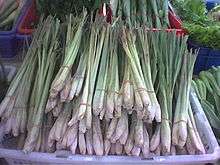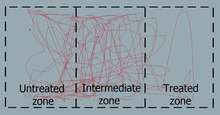Cymbopogon citratus
| Lemon grass | |
|---|---|
 | |
| Scientific classification | |
| Kingdom: | Plantae |
| (unranked): | Angiosperms |
| (unranked): | Monocots |
| (unranked): | Commelinids |
| Order: | Poales |
| Family: | Poaceae |
| Genus: | Cymbopogon |
| Species: | C. citratus |
| Binomial name | |
| Cymbopogon citratus (DC.) Stapf,[1] 1906 | |
| Synonyms[2] | |
|
List
| |
Cymbopogon citratus, commonly known as lemon grass or oil grass, is a tropical plant from South Asia and Southeast Asia.
Cymbopogon citratus is often sold in stem form. While it can be grown in warmer temperate regions, such as the UK, it is not hardy to frost.
Culinary uses
Cymbopogon citratus is abundant in the Philippines and Indonesia where it is known as tanglad or sereh. Its fragrant leaves are traditionally used in cooking, particularly for lechon and roasted chicken.[3]
The dried leaves can also be brewed into a tea, either alone or as a flavoring in other teas, imparting a flavor reminiscent of lemon juice but with a mild sweetness without significant sourness or tartness.
Medicinal uses
The leaves of Cymbopogon citratus have been used in traditional medicine and are often found in herbal supplements and teas. Many effects have been attributed to both their oral consumption and topical use, with modern research supporting many of their alleged benefits.
In the folk medicine of Brazil, it is believed to have anxiolytic, hypnotic, and anticonvulsant properties.[4][5]
In traditional medicine of India the leaves of the plant are used as stimulant, sudorific, antiperiodic, and anticatarrhal, while the essential oil is used as carminative, depressant, analgesic, antipyretic, antibacterial, and antifungal agent.
Laboratory studies have shown cytoprotective, antioxidant, and anti-inflammatory properties in vitro,[6][7][8] as well as antifungal properties | doi=10.1016/j.fct.2010.07.027}}[9] (though Cymbopogon martinii was found to be more effective in that study).
Citronellol is an essential oil constituent from Cymbopogon citratus, Cymbopogon winterianus, and Lippia alba. Citronellol has been shown to lower blood pressure in rats by a direct effect on the vascular smooth muscle leading to vasodilation.[10] In a small, randomized, controlled trial, an infusion made from C. citratus was used as an inexpensive remedy for the treatment of oral thrush in HIV/AIDS patients.[11]
Lemon grass oil contains 65-85% citral in addition to myrcene, citronella, citronellol, and geraniol.[12] Hydrosteam distillation, condensation, and cooling can be used to separate the oil from the water. The hydrosol, as a by-product of the distillation process, is used for the production of skin care products such as lotions, creams, and facial cleansers. The main ingredients in these products are lemon grass oil and "negros oil" (mixture of lemon grass oil with virgin coconut oil) used in aromatherapy.[13]
Pharmacology
One low-dose study found no effect of Cymbopogon citratus essential oils on humans.[14] However, subsequent research has demonstrated that the plants essential oil enhances GABA-ergic neurotranssmision at sufficient doses (with an anxiolytic threshold dose of 10 mg/kg) via positive allosteric agonism in the same manner as benzodiazepines (ex. diazepam) which are used clinically as anxiolytics, sedative/hypnotics, muscle relaxants, and anticonvulsants.[15] Despite the observed pharmacological activity, the average adult male would require 600–800 mg of the pure essential oil to achieve a clinically significant reduction in anxiety. Most commercial supplements contain doses far below the threshold dose which suggests that the majority of lemongrass supplements exert their anxiolytic benefits either primarily or entirely through the induction of the placebo effect. As the essential oil was demonstrated to act synergistically with other GABA-ergics (even in sub-therapeutic doses) and likely also potentiates anxiolytics of other mechanisms (as predicted by the mechanics of benzodiazepines), the possibility of pharmacologically-induced anxiolysis cannot be eliminated when formulations containing a sub-therapeutic lemongrass dosage also contain other anxiolytic herbs/chemicals.
Effect on insects

Beekeepers sometimes use lemon grass oil in swarm traps to attract swarms. Lemon grass oil has also been tested for its ability to repel the pestilent stable fly,[16] which bite domestic animals.
See also
References
- ↑ "Cymbopogon citratus information from NPGS/GRIN". www.ars-grin.gov. Retrieved 2008-03-02.
- ↑ "The Plant List: A Working List of All Plant Species". Retrieved May 8, 2014.
- ↑ "Tanglad / Lemongrass". Market Manila. August 21, 2006. Retrieved July 27, 2011.
- ↑ Blanco MM, Costa CA, Freire AO, Santos JG, Costa M (March 2009). "Neurobehavioral effect of essential oil of Cymbopogon citratus in mice". Phytomedicine. 16 (2-3): 265–70. doi:10.1016/j.phymed.2007.04.007. PMID 17561386.
- ↑ Rodrigues, Eliana & Carlini, E.A. (2006): Plants with possible psychoactive effects used by the Krahô Indians, Brazil. Revista Brasileira de Psiquiatria 28(4): 277-282. PDF fulltext
- ↑ Figueirinha A. Cruz MT. Francisco V. Lopes MC. Batista MT. (2010). "Anti-inflammatory activity of Cymbopogon citratus leaf infusion in lipopolysaccharide-stimulated dendritic cells: contribution of the polyphenols". Journal of Medicinal Food. 13 (3): 681–690. doi:10.1089/jmf.2009.0115.
- ↑ Lee HJ. Jeong HS. Kim DJ. Noh YH. Yuk DY. Hong JT. (2008). "Inhibitory effect of citral on NO production by suppression of iNOS expression and NF-kappa B activation in RAW264.7 cells". Archives of Pharmacal Research. 31 (3): 342–349. doi:10.1007/s12272-001-1162-0.
- ↑ {{Cite journal | title = Suppression of oxidative stress and pro-inflammatory mediators by Cymbopogon citratus D. Stapf extract in lipopolysaccharide stimulated murine alveolar macrophages | journal = Food Chem Toxicol. | date = 2010 | volume = 48 | issue = 10 | pages = 2913–2919 | authors = Tiwari M, Dwivedi UN, Kakkar P
- ↑ Sunita Bansod; Mahendra Rai (2008). "Antifungal Activity of Essential Oils from Indian Medicinal Plants Against Human Pathogenic Aspergillus fumigatus and A. niger" (PDF). World Journal of Medical Sciences: 81–88. Retrieved November 4, 2012.
- ↑ Bastos JF. Moreira IJ. Ribeiro TP. Medeiros IA. Antoniolli AR. De Sousa DP. Santos MR. (2010). "Hypotensive and vasorelaxant effects of citronellol, a monoterpene alcohol, in rats". Basic & Clinical Pharmacology & Toxicology. 106 (4): 331–337. doi:10.1111/j.1742-7843.2009.00492.x.
- ↑ Wright SC. Maree JE. Sibanyoni M. (2009). "Treatment of oral thrush in HIV/AIDS patients with lemon juice and lemon grass (Cymbopogon citratus) and gentian violet". Phytomedicine. 16 (2-3): 118–124. doi:10.1016/j.phymed.2008.07.015.
- ↑ Baby P. Skaria; P.P. Joy; Samuel Mathew; Gracy Mathew; Ancy Joseph; Ragina Joseph (2007). Aromatic Plants. 1. New Delhi, India: New India Publishing Agency. p. 103.
- ↑ Inquirer.net, ‘Tanglad’ goes mainstream, yields essential oils
- ↑ Leite JR, Seabra Mde L, Maluf E, et al. (July 1986). "Pharmacology of lemongrass (Cymbopogon citratus Stapf). III. Assessment of eventual toxic, hypnotic and anxiolytic effects on humans". J Ethnopharmacol. 17 (1): 75–83. doi:10.1016/0378-8741(86)90074-7. PMID 2429120.
- ↑ Costa CA, Kohn DO, de Lima VM, Gargano AC, Flório JC, Costa M (1 Sep 2011). "The GABAergic system contributes to the anxiolytic-like effect of essential oil from Cymbopogon citratus (lemongrass).". Journal of Ethnopharmacology. 137: 828–36. doi:10.1016/j.jep.2011.07.003. PMID 21767622.
- 1 2 Baldacchino, Frédéric; Tramut, Coline; Salem, Ali; Liénard, Emmanuel; Delétré, Emilie; Franc, Michel; Martin, Thibaud; Duvallet, Gérard; Jay-Robert, Pierre (2013). "The repellency of lemongrass oil against stable flies, tested using video tracking". Parasite. 20: 21. doi:10.1051/parasite/2013021. ISSN 1776-1042. PMC 3718533
 . PMID 23759542.
. PMID 23759542.
External links
- Cymbopogon citratus List of Chemicals (Dr. Duke's)
- Cymbopogon citratus from the Biodiversity Heritage Library
- 'Citronella - anticeptic and anti-inflammation' in Vietnam botanical life